
Ashley Cook
April 12, 2021
The process of becoming an artist that is formally trained in the history of art, theory and practice is quite an experience. It is possible that you arrived as an individual relatively sure self who had a passion for image or object making to go with a brief knowledge of the history of art. It is the romantic stories learned from the art history books by Marilyn Stokstad about the lives of Van Gogh, Monet, Manet, Picasso, that cause some people to gravitate towards this life. It can come from a very naive, yet very honest, place.
Going through grueling training on how to see what is in front of you enough to replicate it the best you can is how the process begins; mixing colors perfectly to create color wheels, drawing nudes with charcoal, painting nudes with oil paint, sculpting nudes with clay. And then you are asked why. Why are you interested in being an artist? What will you do to bring art into these contemporary times? How will you be relevant?
Soon after that question begins to enter the conversation, a complete breakdown can occur in the psyche as you are being asked to evaluate your intentions and enter into the depths of your self in order to represent your human experience, somehow, which will inevitably touch on experiences that others have as well because no one is entirely a closed off singular pod. This process leads to a slow deconstruction of the ego with all the highs of excitement and pride and the lows of self doubt, confusion and frustration. Why am I doing this? How will I be relevant? And who determines my relevance anyways? The art world? Well if I want to be successful in the art world, there are these rules to follow. But people who break the rules are the ones who become saints in the art world. But they need to be very knowledgeable about the rules in order to know how to break them in an interesting and effective way, a way that deems them relevant, right? Endless questions...From my experience, it is all a bit masochistic...
The experience is so tender in the pain that it causes, especially with the fact that it can feel so lonely too. And once the process begins, there is a long time of dedication to your work and questions you ask yourself, studying contemporary and historical art, reading and observing, before you begin to understand that it is the art that is teaching you where it wants to go. That part of the process of making work is following your intuition and subconscious mind to allow for the part of you that cannot be communicated through coherent words to communicate through the work. That is one way to work; some would consider it to be quite a romantic approach. There is also the hyper objective hyper self aware approach which nicks the romanticism in exchange for the institutional critique. Active participation in art discourse does require compromise as well as self awareness no matter what position you would like to develop in your work, however at the beginning, the romanticism seems to take the lead as it keeps one emotionally invested. It makes it easier to willfully stick to it despite what can be a thick and heavy process of dissolution.

The exhibition (unsee to discover) at 333 Midland in Highland Park encompasses the work of nine artists who have reached the end of their BFA program in Fine Art at College for Creative Studies in Detroit, Michigan. A series of words emerged during a recent exercise amongst this group; they used these words to describe their work. With this exercise as a tool to tap and funnel their own self-awareness, it assists in the read of the work, functioning in tandem to the artist statements and documentation.
D(th)isplace(2)nt
Space
Inside “inner”
Between
Outside
Membrane
Hidden
Revealed / Behind Close Doors
Peep Show
Longing
Understanding/ Wanting to be understood
Do you understand me?
The common theme amongst the mindset of these artists is in their communication of an experience similar to seeing the world through a sheer translucent veil. Whether intentional or not, the recognition of the relationship between the inner and outer world is at play, and there is no filter that is attempting to hide this current state of mind.
Ego-death is a universally acknowledged phenomenon experienced by many people around the world. Also referred to as “psychic death” or “the hero’s journey”, it is usually associated with the concept of “enlightenment” through the intentional or unintentional deconstruction of the self. It has been defined as “the renunciation, rejection and, ultimately, the death of the need to hold on to a separate, self-centered existence”1 or “temporarily experience[ing] a complete loss of subjective self-identity“.2
What is interesting and particularly relevant about this process these days is that the experience of psychic death opens the door for a way of thinking referred to as “radical pluralism”. Kids experience this in life when they begin to reject their parents’ lifestyles and ways of thinking in order to venture into the unknown.3 But when relating it to art, we can easily link it to the project of Post-Modernism and its denial of the universal truths and objective realities that Modernism attempted to uphold4 in exchange for a pluralistic approach to producing and appreciating Art.
“Pluralism in art refers to the nature of artforms and artists as diverse. The cultural context of art is all encompassing in its respect for the art of the world’s cultures. Inclusion of individuals of differing ethnicities, genders, ideologies, abilities, ages, religions, economic status and educational levels is valued. Pluralism honors differences within and between equitable groups while seeing their commonalities.“5
This comes as both a blessing and a curse, because on one hand, “artists and art theoreticians alike are glad to be free at last from the obligation to conform to the historical laws and requirements” of what it means to be an artist and instead are able to be “politically and culturally engaged in social reality [and] reflect on their own cultural identity, express their desires, and so on.”6 But on the other hand, there are really no rules or straight path that you can follow to help you find success. Or, maybe there are some, but even those are elusive and ever changing. For better or worse, this expanse of freedom prompts artists to dive deeper into themselves in hopes to discover what they really want to do or say with their work.
We can see this group of nine artists as active participants in this pluralistic approach to creative production. There is a perceived incongruence between the group as the aesthetic decision making and material choices vary widely. However, beyond the surface level, I have located consistency in their investigations of the inner world vs. outer reality through, for instance, open discussions about experiences of diaspora, dysmorphia and the collapse and regeneration of meaning.
Noor Albahrani exercises this in a particularly potent and brave way through the way in which she presents her artist statement.
.jpg)
The cut and paste, deconstructed, blocked out use of layout is continued in her works in the exhibition as well. In her painting The Journey, Noor depicts a ship on a rocky sea, which is imagery that has continued to be used throughout the other works. Noor uses The Search and Vivisection to illustrate her continued journey to reconnect with her heritage while also activating conversation surrounding the effects of diaspora and Orientalism (the Western distorted depiction of the Orient). “With paint, I can explore this void, uncover it, assign dimensions to it, and maybe find how this all began”.
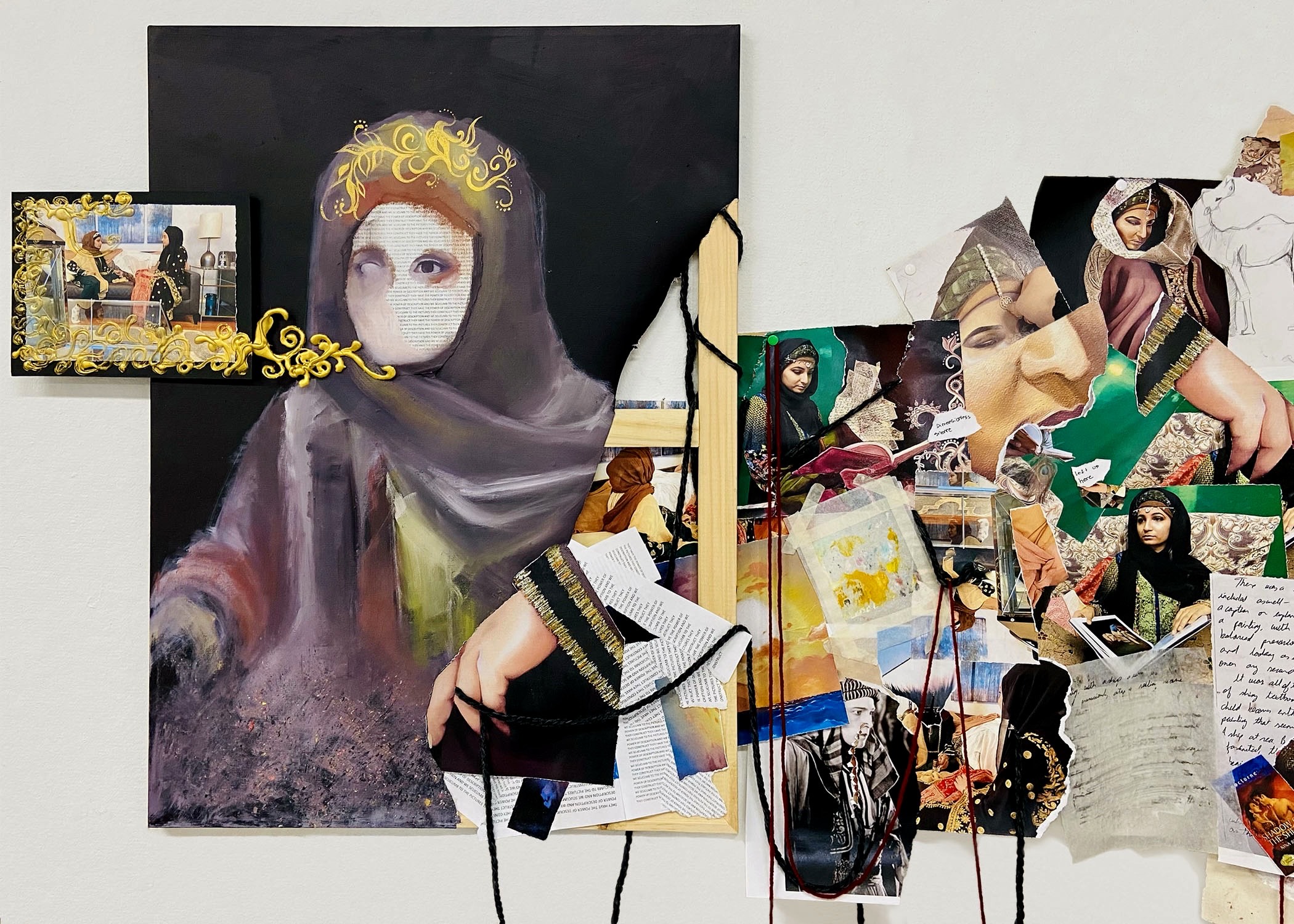
Noor is working through a character in order to understand and communicate the feeling of “dimensionless silence”. This effort to convey a narrative but also remain open ended is a steady balance between order and disorder, construction and deconstruction. But perhaps it is okay to never find the end...what would it mean to find the end? Is there an end? Or is it about the process of searching that brings the meaning?
A very similar foundation for working is exercised through the practice of Cailyn Dawson who writes “in my work I am interested in exploring and visualizing the displacement and separation that I feel from my African and Hispanic heritage. My mother is half Black and half Mexican and my father is Black. Because of my feelings of displacement and separation, I long for a connection I do not have.”
While in conversation with Cailyn Dawson in her studio, we discussed the emotional and psychological effects that diaspora has on identity. Similarly to Noor Albahrani, there is the question of balance between order and disorder, construction and deconstruction and the search for belonging.
“I depict these themes in many ways. I paint my hands in acrylic paint on the canvas detached from my body. The hands start to become a caricature of myself, there is no arm attached to them as a way to visualize that separation that I experience. In other paintings, there are full figures with their faces missing...Our faces are considered the number one identifier on our body so by excluding the face, I am taking away the figures identity.” She use other symbolism as well, such as “hands holding objects that don’t belong to a certain culture or an object that is popular in Black culture to show that even though I have lost the connection to my African heritage, I’m still part of a vast culture that I am proud of.”
Her use of unstretched canvas and relatively raw painting style effectively functions as a technique to illustrate this feeling of undoing or not belonging. My question for Cailyn when speaking about the work was whether creating the work is about the expression of the feeling of diaspora, the journey of finding a sense of belonging or is the process guided by a desire to find something specific? Perhaps in the end, it is about all of that at once.
The artist Mars Richardson openly expresses their reason for making work, which is to investigate the “psychology and mental illnesses that stem from [their] own personal life.” They recognize that mental health is still a challenging topic to speak openly about, however as a way of healing and overcoming these challenges, Mars communicates openly about their experience with C-PTSD, PTSD, OCD (manifesting as trichotillomania and dermatillomania), Generalized Anxiety Disorder, Chronic Clinical Depression, ADHD, Acute Stress Disorder, and Body Dysmorphic Disorder. “My artwork represents physical embodiments of mental disorders (namely the ones that I have) that force the viewer to come face-to-face with the reality of each of them and perceive what is typically ‘unseen’. What most inspires me is to have the chance to create work that physically immerses those without a specific disorder in the reality and simulated-symptoms to hopefully aid them in a better understanding of what mental illness is like. Another would be a physical reminder to those who are like me that they are not alone; they are heard and they are valid.” While in conversation with Mars about the effectiveness of their practice to address these conditions and hopefully get past them, they expressed that through the process of planning, to making, to reflecting, making art has helped significantly with understanding them and where they come from. “I recognize the importance of art as a coping mechanism, healing tool, and form of education, which is why I have decided to also major in Art Therapy.”
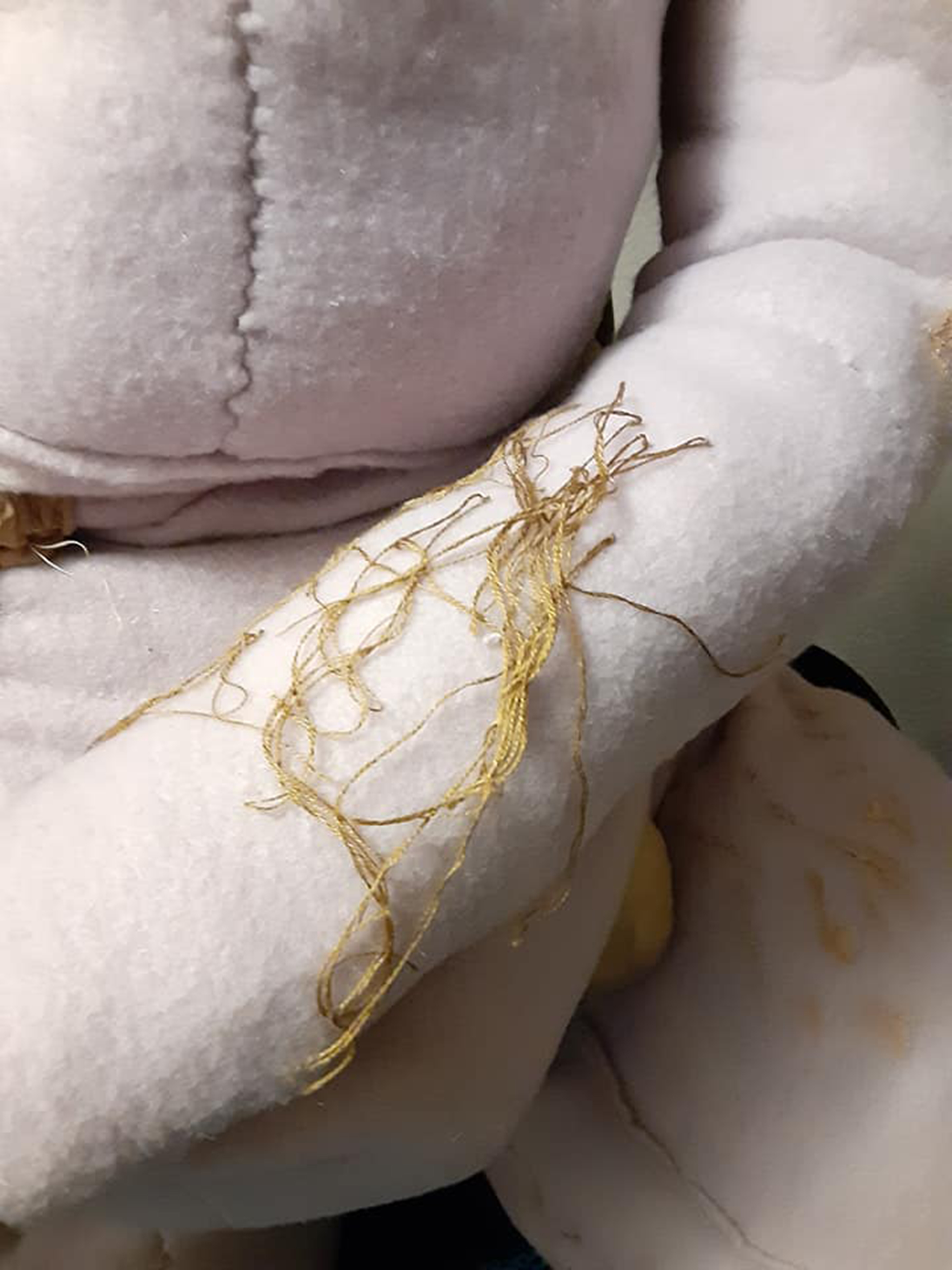
Olivia Russo writes in her artist statement “my work involves physically mapping out internal feelings that one might experience during a time of darkness versus a time of growth.” Through the practice of creating using what is available around her, Olivia works to give meaning and purpose to otherwise discarded items. Like the comfort and intimacy of writing in a diary, her approach to constructing is often based on personal emotion with, for instance, the use of wire to express harshness or ribbon for a gentle touch.
She describes her process as involving “creating drawings, tweaking and experimenting, finding interesting pieces of paper to scribble on and attach, taking time to carefully render illustrations as well as making bold, impulsive moves that serve as the map that guides the process”.
.jpg)
Ana Miryam Barrera is also an artist that is highly concerned with the coexistence of the outer and inner world, working to acknowledge the two as important to each other.
“The change that happens as a result of the interactions from person to person breeds a parallel reaction in an internal world. It is the landscape within, shaped by the reactions to emotion and thought process. The internal world is reflected in the work I make, it is that which houses the mass that exists within each individual. I look at the undulating shifts that occur internally as one grows and changes to match or defy the structures and opinions that surround us.”
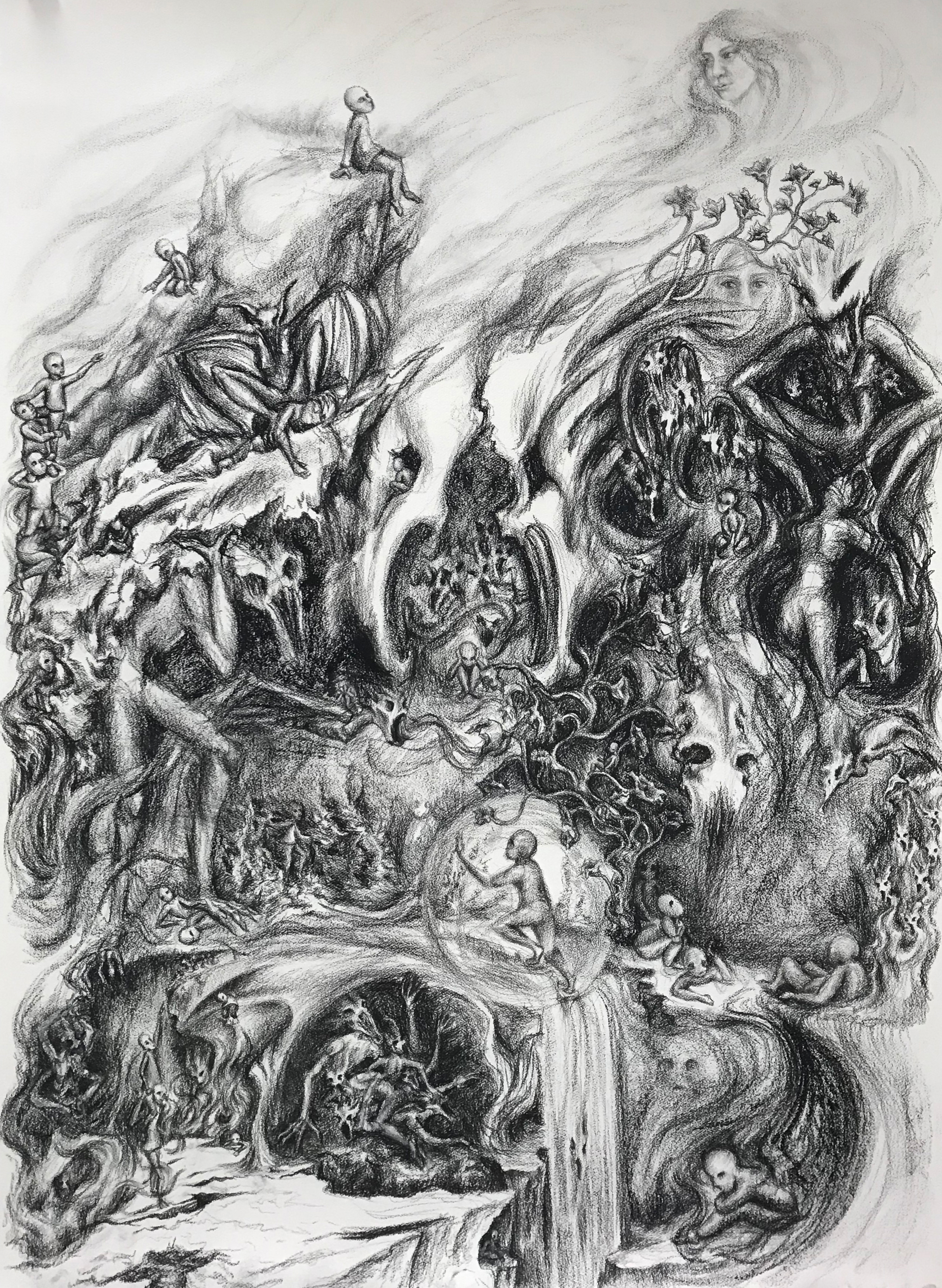
Ana has developed a unique language to describe this inner world, which she considers “a world of the mass that houses the beings that live inside the mind. Creatures are birthed from the seeds of expectations, fears, perceptions, and toxic lessons that take root within. They are the conflict inside that carry with them the burdens of their own origin. The shlumpies are clots of mass that struggle with the changing landscape that moves them, defying, morphing, broken, and resilient. They are the anonymous fractions of a person that move inside.”
“As I work, I delve into the mind, taking time to reflect and analyze my story as well as those that have been entrusted to me, seeking to find the way that each individual navigates the undulations of their own lives. The work then becomes a mirror to this. I then let these considerations flow out into an idea and eventually an image. Each landscape is created through a reactive process, in which I give room for the work to become a response of itself, allowing one mark to dictate the next.”
Sarah Rasmussen approaches creative production in a way that more closely focuses on the erasure and reinvention of meaning. As if in a dream, she makes work in a way that is “inspired by the ways in which stimuli are consumed within the context of the 21st century. I find myself constantly examining, questioning, and reconsidering the ways in which we create and break down meaning.”
“For me, creating is an act of purging, cleansing, or catharsis, a way of manifesting an otherwise internalized perspective. Ideas stem from everyday stimuli, the act of observing and questioning, analyzing, photographing, dreaming, and watching movies. While exploring ideas of ego, identity, self, awareness, observation, the nuances of visual storytelling/ organization, and the complications of 21st century visual culture, I embrace and consider the multiple angles which refract our lives. I am interested in tensions between the real, and the pull of fantasy; the veil of the superego, and the place where meaning collapses.”
 2.jpg)
The work touches on themes of the in-between, portals, the relationship between fantasy and reality and a pushing of parameters. The act of viewing, discussing and unpacking this work feels almost like the experience of being in a dream vs. trying to describe the dream later.
Kristen Mesa also investigates the contexutalization and recontextualization of meaning. Touching on her practice, she recognizes her work to “serve as vessels relating to the expression of familial relationships and perceptions of self and identity.” Specific forms, object and patterns are used that are associated with the context of “home” like decorative objects and textiles. “A quilt is an object meant to provide comfort till it becomes a painting.” Kristen plays with the homeliness of the objects she uses and attempts to find tensions within the materials by pulling the objects away from their typical narratives.
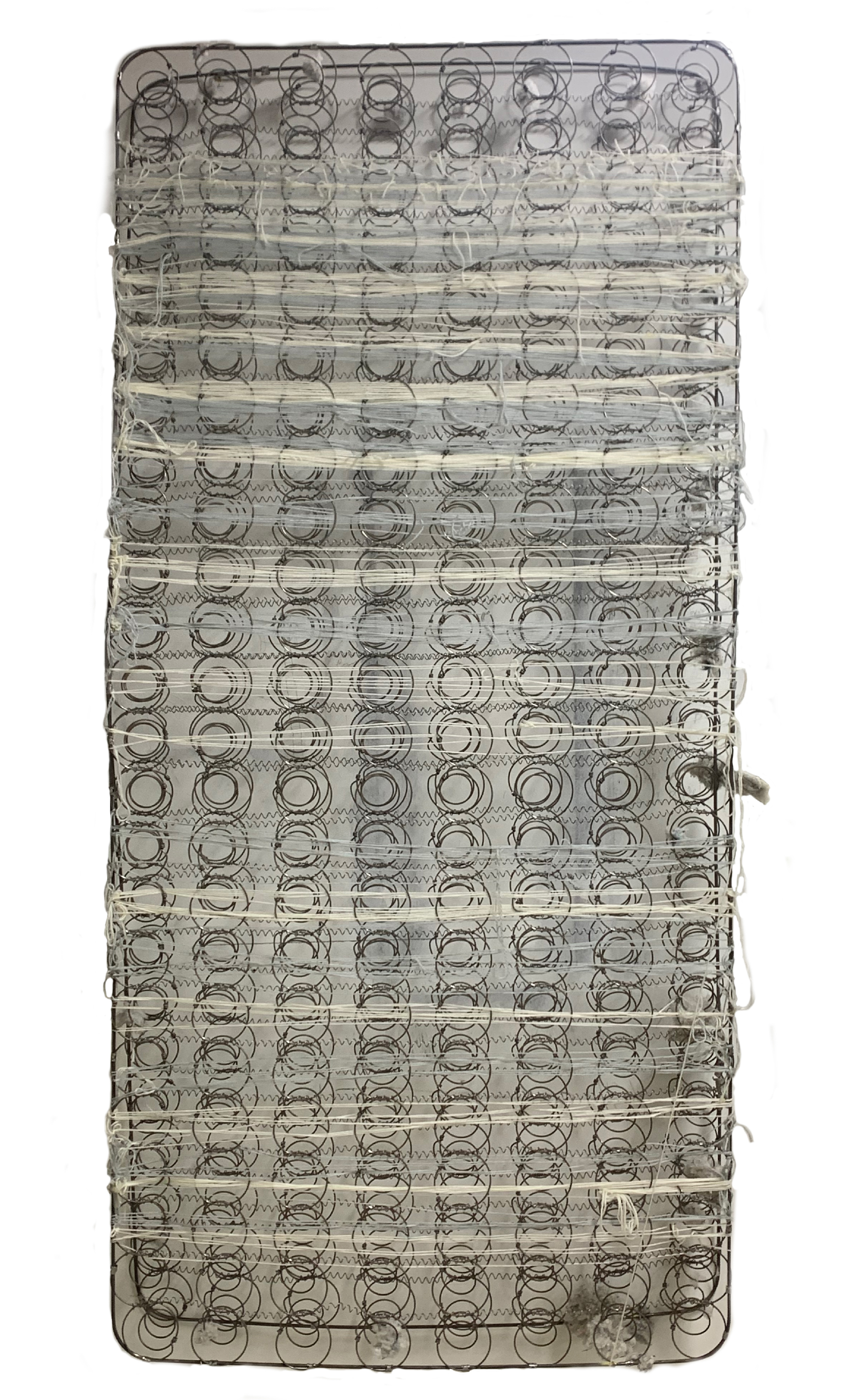
The humor and light-hearted attitude that comes through in the work of Melanie Kelley honors an absurdity and even a gentle level of nihilism that she describes as similar to the deconstruction of the meaning of a word when you say it too many times. Through a deliberately “disengaged intimacy”, it can make the world that we take so seriously feel ultimately meaningless, but then reminds us that maybe that in itself is its meaning.
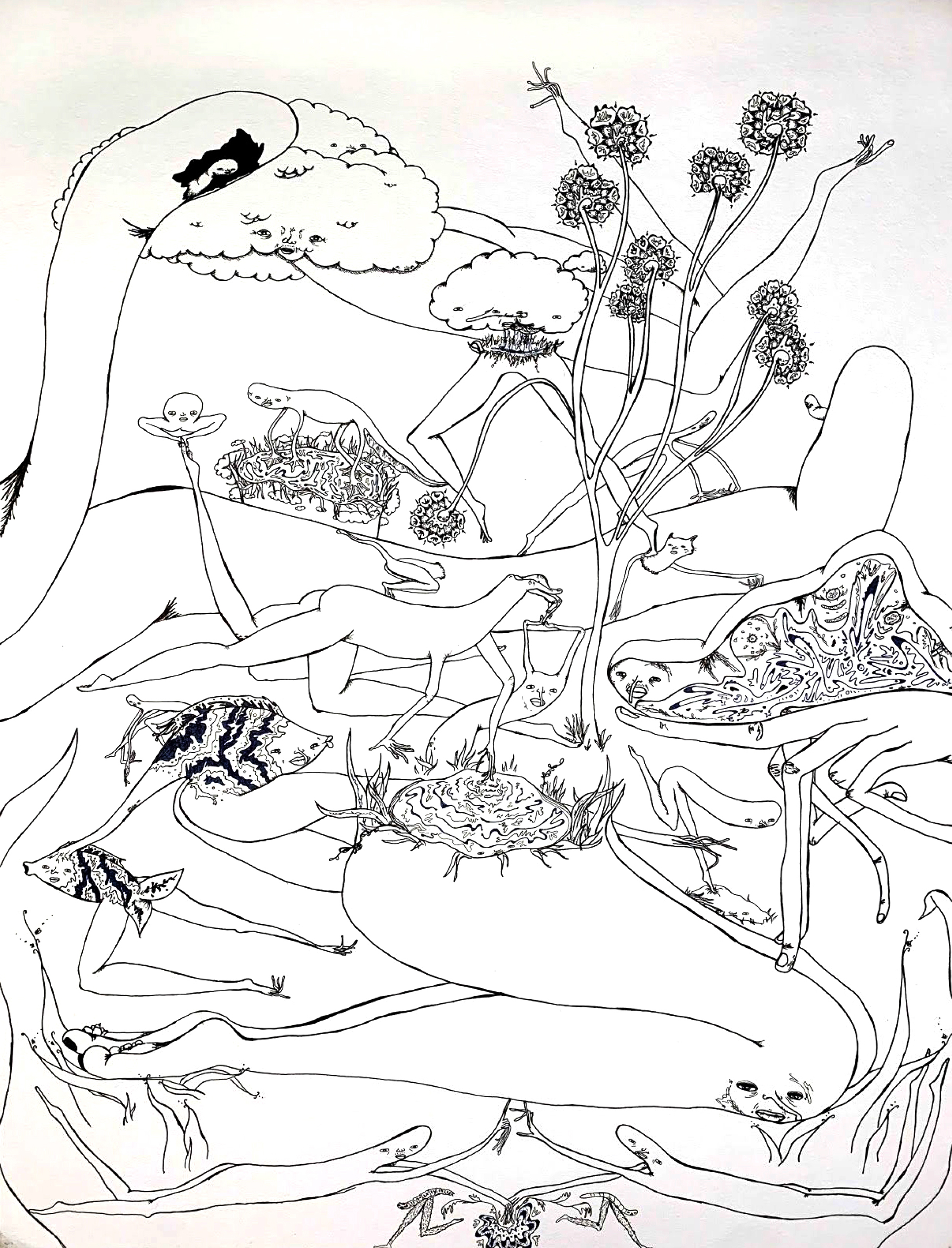
“My work seeks to invite the viewer to be a part of its vacuous and mystical, systematically lawless world, but, alas, the invite is hollow and the work watches at a distance as the audience projects systems, understanding, and systems of understanding upon it. The infinite overlay of meaning and meaninglessness is the bed from which my work sprouts; this mirrored tunnel of losing and gaining meaning (and still learning from both) is an ever fertile womb, forever creating- long past my authorship. Thus, I give birth to characters, languages, and laws that mirror many of those with which the audience may be familiar. These components (much like ourselves) only exist through relation: to each other, to the viewer, to culture, to sense, to the natural world, and beyond- they do not sensically stand on their own.”
This sensibility of existing in relation to one another is the underlying themes in this exhibition and each artists work in one way or another.
The use of humor, play and absurdity is also evident in the work of Kaio Huvaere who presents something like a poem to talk about his work before diving deeper into the reasoning behind his decision making.
“Public Masturbation
Singular experiences that become communal
Crashing Cars
I use sculpture, video, and installation to elongate the shorthand experience of the internet, creating physical spaces that function like digital spaces, and exploring the tensions of existing in both.”

Just as his fellow artists in this exhibition, Kaio is working to understand and express what he refers to as the “singular experiences that become communal” while also touching on the affects that we are experiencing in the digital age. It is a common phenomenon to be both intimately engaged and very disengaged simultaneously while having an existence online. It takes our experiences of the micro and makes them macro and our macros become micro. Kaio presents this expanding and shrinking reality through installation, simulations and video works in an attempt to merge these two poles and “document this fragile period of time we exist in before complete digital.”
It is thought provoking to consider the role that the internet has actually played in the development of Pluralism. It is as if before our very easy access to different cultures around the world, the idea of true and free expression existed inside something so dense that it suddenly exploded into an anarchic and wild world of internal and external perspectives all existing on one relative plane. Not only is freedom more openly applied to the use of language, materials, sound, form, etc., but it is also done so at a speed that is faster and faster every day. There are many challenges that come with adapting to this kind of world, as well as trying to digest and understand it. But, whether the approach is done with a sense of crude humorous play, sensuality, grief, sadness, confusion or just a general curiosity about it all, each has an equal chance in the ring. And now the question arises; how far should we go down the rabbit hole?
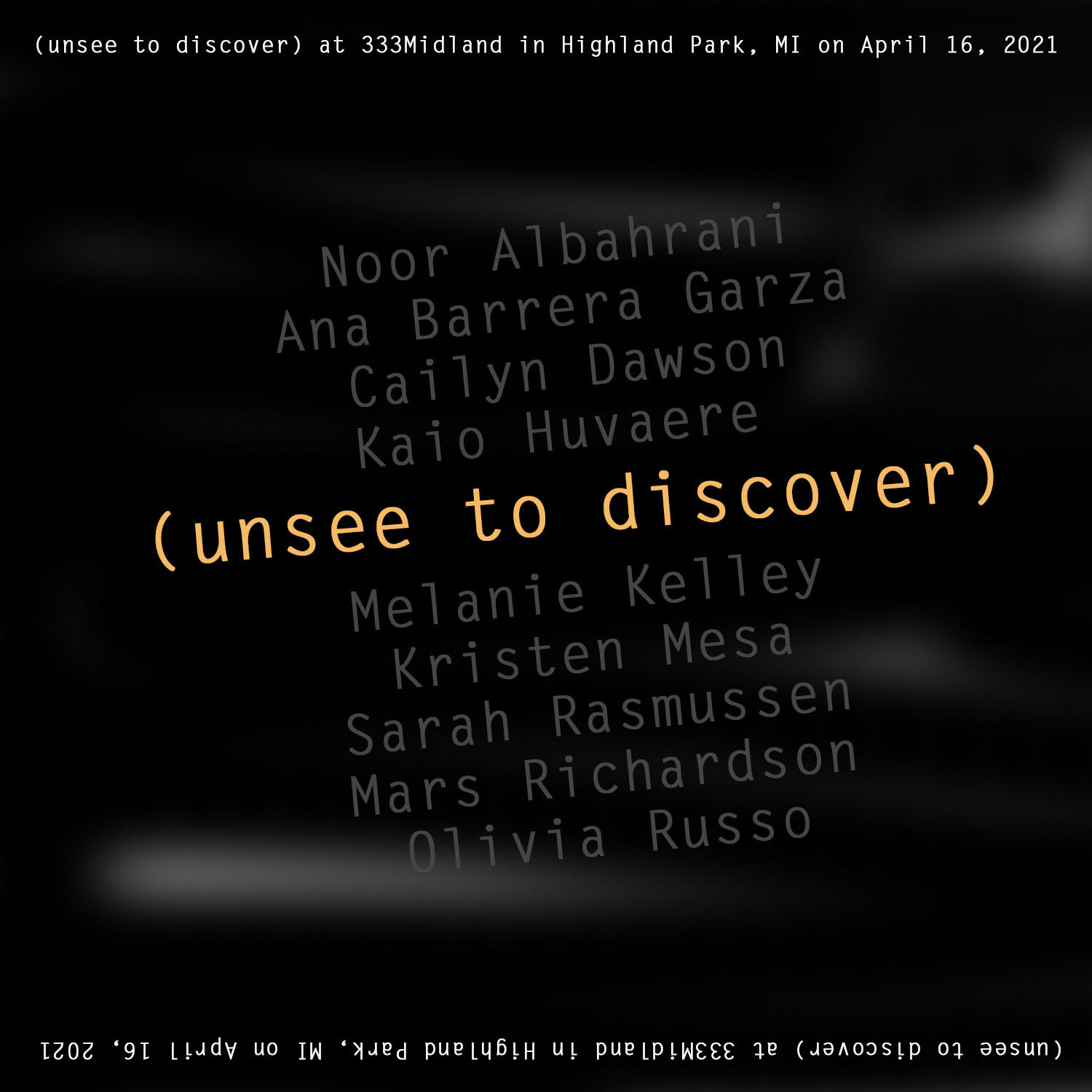
(unsee to discover)
at 333Midland, Highland Park, Michigan
Opening April 16 : 5-8pm
Continued on Saturday April 24 : 2-5pm
and Saturday May 1 : 2-5pm
*rsvp at https://unseetodiscover.eventbrite.com/
1. “Ego Death,” Wikipedia, lasted edited March 23, 2021, Link.
2. “Ego Death”
3. “Ego Death”
4. “Postmodernism,” Tate, Link.
5. “Pluralism,” 1999-2000, New Art Basics Database, Link.
6. Boris Groys, On The New (Universitat Oberta de Catalunya, December 2002), page 1.